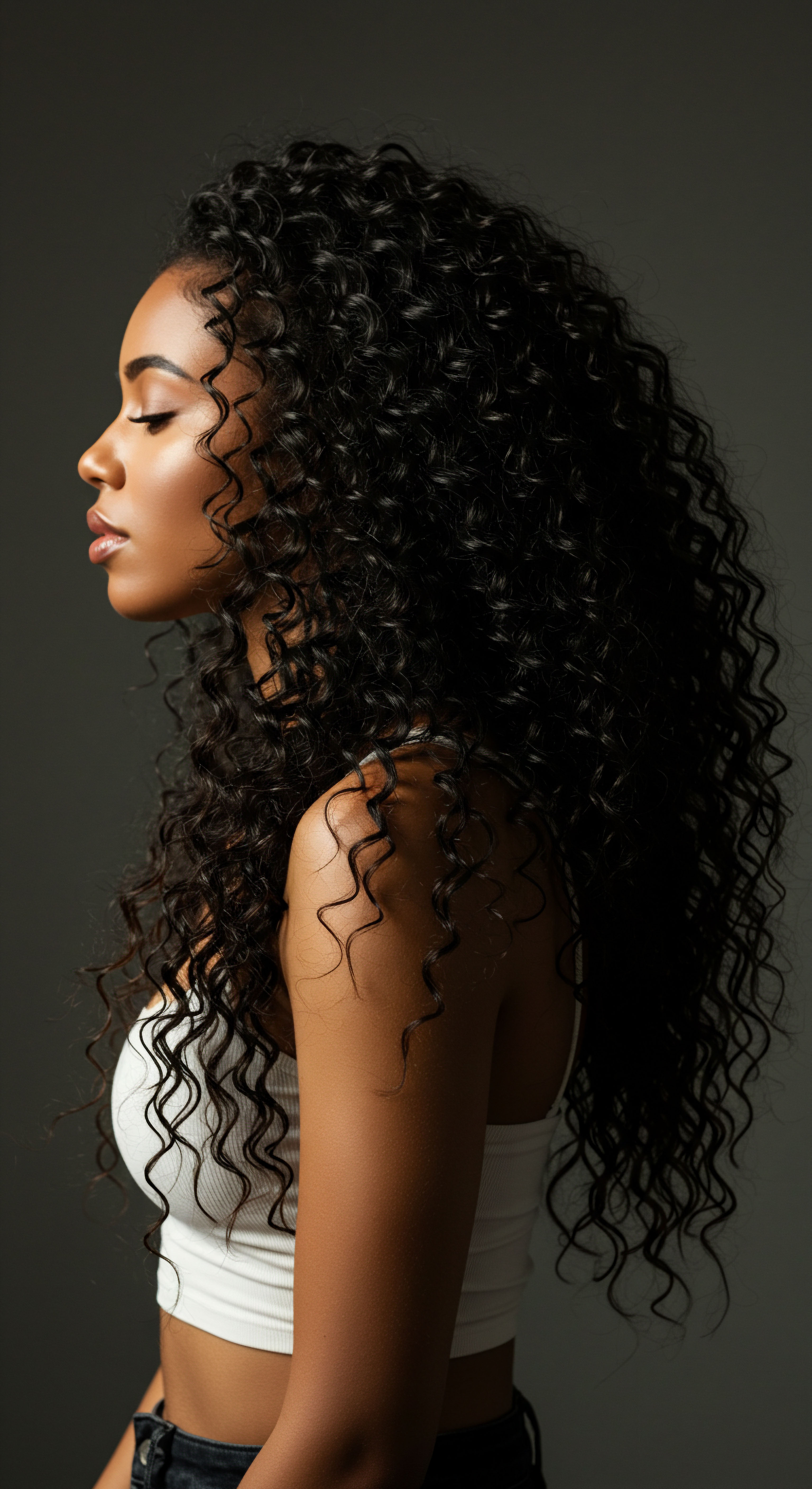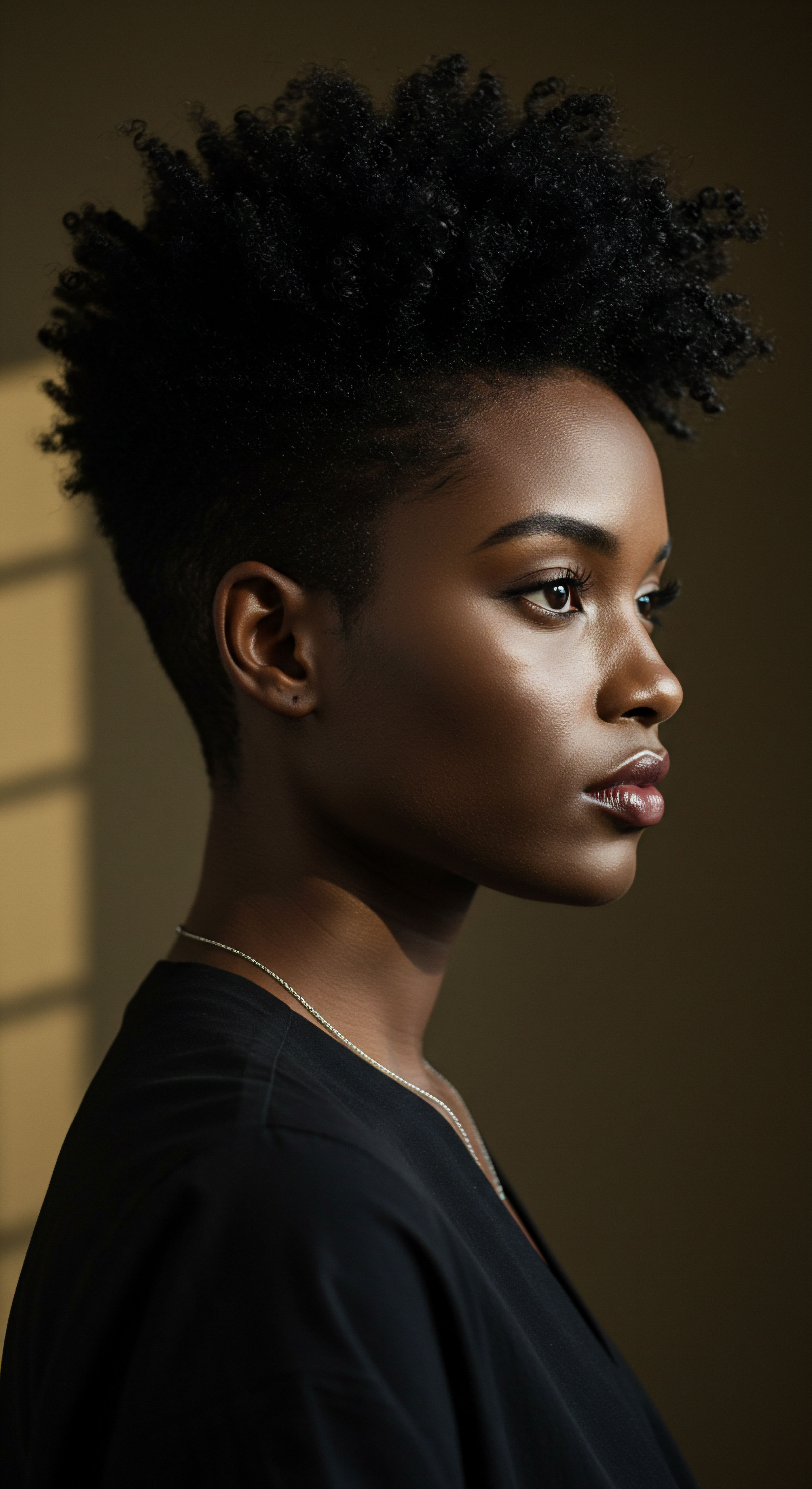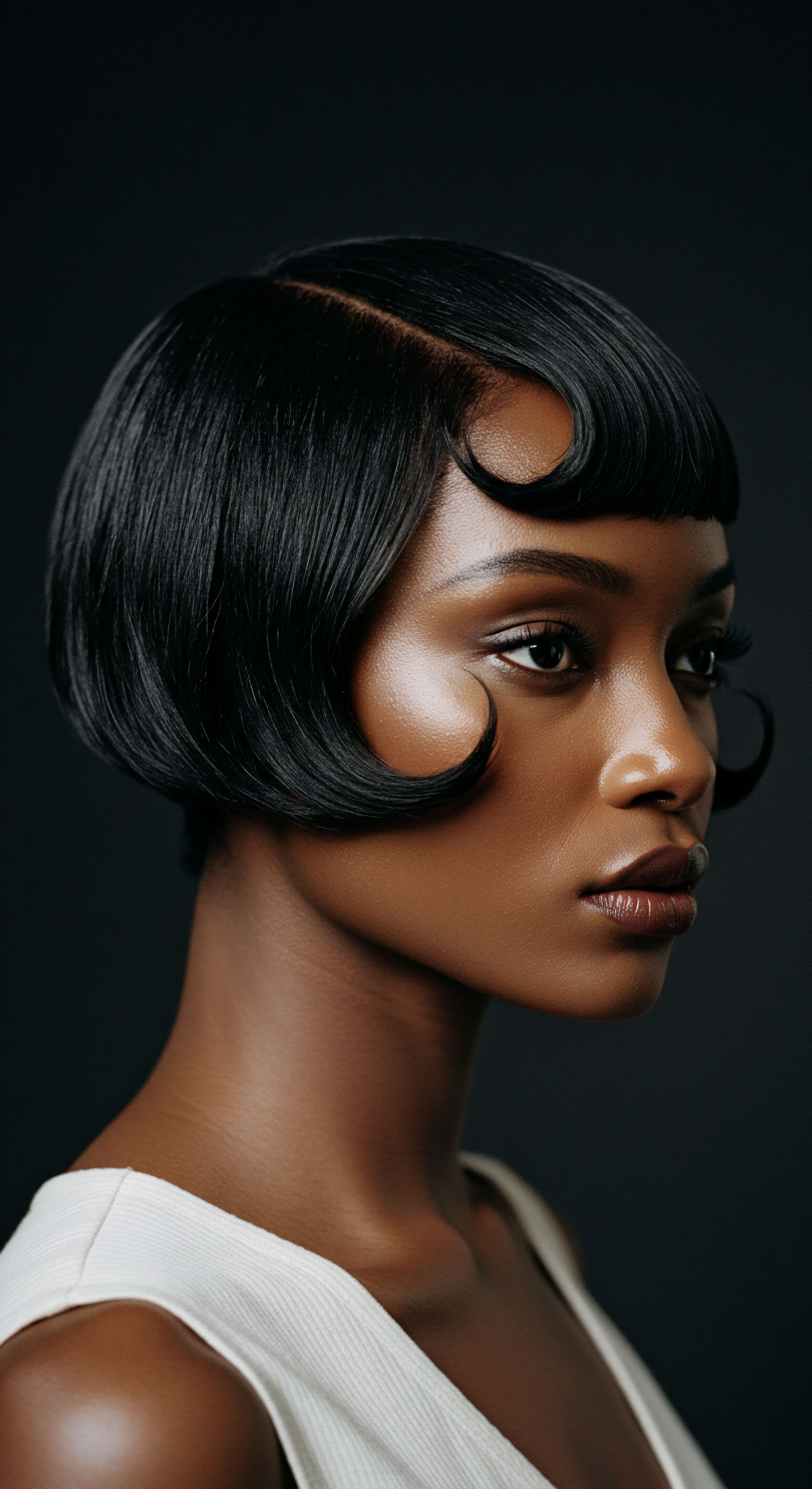
Roots
The night, a time for rest and rejuvenation, holds a quiet power over our coiled strands. As we drift into slumber, our hair, with its unique and intricate structure, begins a nightly interaction with the surfaces it touches. This interplay, often overlooked, subtly shapes its hydration, its resilience, and its very well-being. It is a dialogue between the delicate architecture of a coiled hair fiber and the textures of our sleeping environment, a conversation that can either nurture or diminish its natural moisture.
To truly understand how sleep surfaces affect coiled hair hydration, one must first peer into the very essence of a hair strand. Each individual hair is a marvel of biological engineering, composed of distinct layers that work in concert to protect and maintain its integrity. At its heart lies the Medulla, a soft, innermost core, though not all hair types possess one. Surrounding this is the Cortex, a robust layer of fibrous proteins, pigments, and moisture, which largely dictates the hair’s strength, elasticity, and color.
The outermost layer, the Cuticle, acts as a protective shield, a series of overlapping, scale-like cells resembling shingles on a roof. These cuticular scales, when healthy and smooth, lie flat, reflecting light and creating a lustrous appearance while locking in vital moisture.
Coiled hair, by its very nature, presents a distinct set of characteristics. Its helical shape means that natural oils, produced by the scalp, face a more challenging journey descending the hair shaft. This inherent structural quality can render coiled hair more susceptible to dryness compared to straighter textures. The cuticle, too, is often more exposed at the curves and bends of a coil, making it particularly vulnerable to external stressors.
When these cuticles are lifted or roughened, the hair’s ability to retain moisture diminishes, allowing water to escape more readily from the cortex. This constant battle for hydration becomes a central theme in the daily care of coiled hair, extending even into the hours of sleep.

The Architecture of Hair Hydration
Hydration in hair is not simply about water, but about the delicate balance of water content within the hair fiber and the presence of lipids that help seal that moisture within. The F-Layer, a natural lipid coating on the hair’s surface, plays a significant role in maintaining this balance and reducing surface friction, especially when hair is wet. When this protective layer is compromised, whether through daily styling, environmental exposure, or mechanical friction, the hair becomes more porous, meaning its cuticles are raised, allowing moisture to enter and escape more easily. This can lead to hair that feels rough, appears dull, and is prone to breakage.
The porosity of hair, a term describing its ability to absorb and retain moisture, is deeply connected to the state of its cuticle. Hair with low porosity has tightly bound cuticles, which resist moisture absorption but also retain it well once hydrated. High porosity hair, on the other hand, has more open or raised cuticles, readily absorbing moisture but also losing it quickly.
Coiled hair often exhibits a range of porosities, and understanding one’s own hair’s porosity is a foundational step in optimizing its hydration. The constant mechanical interactions during sleep can exacerbate existing porosity issues or create new ones, directly influencing the hair’s moisture levels by affecting the integrity of these protective cuticular scales.
The intricate structure of coiled hair, particularly its naturally raised cuticles at curves, renders it more susceptible to moisture loss during sleep.

What is Hair’s Water Content?
The idea of “hydration” in hair often brings to mind a saturated, plump strand. Yet, scientific perspectives reveal a more nuanced reality. Hair that feels soft, smooth, and healthy often possesses a lower water content than hair that feels rough or damaged. This counterintuitive truth arises from the microscopic behavior of water on the hair’s surface.
When hair absorbs excess water, particularly into the areas beneath the cuticle scales and the “glue” between them, these scales can lift, creating a bumpier, rougher surface. Water itself, at a microscopic level, can also increase friction due to surface tension, making wet hair feel more “grippy” and, paradoxically, less smooth.
This phenomenon underscores that optimal hydration is not about maximizing water absorption, but about maintaining a balanced internal moisture level and a smooth external cuticle. The natural conditioning layer, the F-layer, helps to provide this smoothness and protection. When sleep surfaces contribute to cuticle lifting or stripping this layer away, they directly interfere with the hair’s ability to feel and appear hydrated, even if water is present within the cortex. The interaction with fabrics, therefore, becomes a critical determinant of how well the hair’s outer defense remains intact throughout the night.

Ritual
As the day draws to a close and the quiet of night descends, a series of deliberate choices can profoundly shape the well-being of coiled hair. This time, often seen as a simple cessation of activity, holds the potential for either gentle care or unwitting damage. The way we prepare our hair for rest, and the surfaces it encounters during those hours, form a nightly ritual that directly influences its hydration levels and overall health. It is a practice of mindful preservation, moving beyond mere habit to a purposeful act of nurturing.
For generations, individuals with textured hair have instinctively understood the need for nighttime protection. From the wrapping of hair in soft cloths to the use of bonnets, these traditions were not simply aesthetic choices but practical measures to shield delicate strands. Modern science now illuminates the underlying reasons for these practices, revealing how the choice of sleep surface, whether a pillowcase or a head covering, acts as a silent guardian or an unseen adversary against moisture loss and mechanical stress.

The Fabric of Dreams and Hair
The material against which hair rests for hours each night plays a significant part in its hydration story. Cotton, a common pillowcase material, is known for its absorbency. While this quality makes it comfortable for absorbing sweat, it also means cotton readily draws moisture, including the natural oils and any applied products, directly from the hair.
This can leave coiled hair, already prone to dryness, feeling parched and brittle upon waking. The rougher texture of cotton fibers can also create friction, leading to lifted cuticles, tangles, frizz, and even breakage.
In contrast, silk and satin offer a different experience. These materials possess a smooth, slippery surface that significantly reduces friction between the hair and the pillowcase. This allows hair to glide effortlessly as one shifts during sleep, minimizing mechanical stress on the cuticle.
Beyond friction reduction, silk, as a natural protein fiber, is less absorbent than cotton, meaning it is less likely to strip hair of its essential moisture and natural oils. Satin, while often a synthetic weave (like polyester or nylon), mimics silk’s smooth texture and provides similar benefits in terms of reduced friction and moisture retention compared to cotton.
| Material Cotton |
| Friction Level High |
| Moisture Absorption High |
| Impact on Coiled Hair Hydration Absorbs natural oils and applied products, leading to dryness. Causes frizz and breakage. |
| Material Silk |
| Friction Level Low |
| Moisture Absorption Low |
| Impact on Coiled Hair Hydration Helps hair retain natural moisture and applied products. Minimizes frizz and breakage. |
| Material Satin (Synthetic) |
| Friction Level Low |
| Moisture Absorption Low to Moderate |
| Impact on Coiled Hair Hydration Mimics silk's benefits in reducing friction and helps retain moisture better than cotton. |
| Material Selecting a sleep surface with low friction and low absorbency is paramount for preserving coiled hair hydration. |

Does the Type of Head Covering Really Make a Difference?
The simple act of covering hair before sleep, whether with a bonnet or a scarf, can be a cornerstone of a protective nightly regimen. These coverings create a personal micro-environment for the hair, shielding it from the abrasive qualities of bedding materials and helping to maintain a more consistent level of humidity around the strands. A silk or satin bonnet acts as a cocoon, preserving natural oils and applied hydrating products by preventing them from being absorbed by a cotton pillowcase. This physical barrier also minimizes the mechanical stress that leads to cuticle damage, frizz, and tangles, particularly for delicate coiled textures.
Choosing a bonnet or scarf made from silk or satin provides the same advantages as a pillowcase of the same material, but with the added benefit of keeping all hair contained, regardless of tossing and turning. This is particularly useful for those with longer hair or those who move significantly during sleep. The enclosed environment also helps to concentrate any leave-in conditioners or oils, allowing them to penetrate more deeply into the hair shaft overnight, further supporting hydration.
- Silk Bonnets offer a gentle, breathable enclosure, preserving natural oils and minimizing friction against delicate strands.
- Satin Scarves provide a smooth barrier, reducing tangles and helping maintain moisture levels, especially for hair prone to dryness.
- Loose Braids or buns secured with silk scrunchies minimize movement and tension, protecting hair from breakage while promoting hydration.

Nighttime Hair Preparation
Beyond the sleep surface itself, the ritual of preparing hair for rest significantly contributes to its hydration. Applying a lightweight hair oil or serum before bed can help to seal the hair cuticle, creating a protective barrier that reduces moisture loss. Gently detangling hair with a wide-tooth comb, starting from the ends and working upwards, helps prevent knots from forming overnight, which can otherwise lead to breakage and further cuticle damage.
For coiled hair, specific protective styles can further enhance the benefits of a smooth sleep surface. Loose braids, twists, or a pineapple (a high, loose ponytail at the crown of the head) reduce the hair’s contact with the pillowcase and prevent tangling. These styles also help to preserve curl patterns, reducing the need for extensive restyling and potential heat application in the morning, which can further deplete moisture. The conscious choice of how hair is gathered and secured, utilizing soft ties like silk scrunchies, ensures that no undue tension is placed on the hair follicles, supporting overall hair health and hydration.
Choosing smooth, low-friction sleep surfaces like silk or satin can significantly reduce hair damage and preserve moisture for coiled hair.

Relay
Beyond the visible benefits of smoother strands and retained moisture, the subtle dance between coiled hair and its sleep surface extends into deeper realms of trichology, cultural heritage, and the very biophysics of friction. This exploration moves beyond simple observation, inviting us to consider the intricate interplay of forces and traditions that shape the health and appearance of textured hair during its nightly repose. It is a convergence of ancestral wisdom and contemporary scientific inquiry, each illuminating the profound impact of seemingly small decisions.
The discussion of sleep surfaces for coiled hair is not merely about comfort; it is about mitigating constant, microscopic mechanical stress. Our bodies shift, on average, up to 40 times each night, creating repeated contact and friction between hair and bedding. This continuous rubbing, especially against rougher fabrics, causes the hair cuticle to lift, chip, and even break.
For coiled hair, where the cuticle is already more exposed at the bends, this vulnerability is heightened. This constant disturbance compromises the hair’s natural barrier, leading to increased moisture loss and a cascade of issues from frizz to breakage.

The Biophysics of Hair Friction and Hydration
The science of tribology, the study of friction, lubrication, and wear, offers profound insights into the interaction between hair fibers and textiles. Hair, particularly coiled hair, exhibits complex frictional properties. Research has shown that the friction coefficient of hair is influenced by its shape, with wavy hair sometimes exhibiting higher friction coefficients due to a larger contact area. When hair rubs against a surface, the friction generated can be significant.
Cotton, with its relatively rough and absorbent fibers, creates a higher coefficient of friction compared to smoother materials like silk or satin. This difference in friction directly correlates with the degree of cuticle damage and, by extension, the hair’s ability to retain hydration.
A study comparing the friction coefficient and electrostatic charge generated from the sliding of various head scarf textiles against human hair (including African and Asian hair types) found that cotton displayed the highest friction coefficient, followed by nylon, then polyester. Specifically, at light loads, cotton showed friction values reaching 1.45 and 1.55 for Asian and African hair, respectively, whereas polyester displayed values as low as 0.54. This quantifiable difference in friction means that cotton surfaces physically abrade the hair cuticle more aggressively than smoother materials, leading to greater mechanical damage and subsequently, greater moisture evaporation from the exposed cortex.
The smooth, protein-based structure of silk, specifically its fibroin protein, gives it a naturally lower coefficient of friction, allowing hair to glide without snagging or lifting the delicate cuticular scales. This preserves the hair’s natural barrier, keeping hydration sealed within.

How Does Material Absorbency Affect Coiled Hair Moisture?
Beyond friction, the hygroscopic properties of sleep surfaces directly influence hair hydration. Cotton, a hydrophilic fiber, readily absorbs water from its surroundings. This includes the natural sebum produced by the scalp, any leave-in conditioners, or styling products applied to the hair.
When hair rests on a cotton pillowcase for several hours, the fabric acts like a sponge, drawing essential moisture away from the hair shaft. This leaves coiled hair drier, more prone to frizz, and susceptible to breakage.
In contrast, silk, being a protein fiber with a tighter weave, is significantly less absorbent than cotton. It allows the hair to retain its natural moisture and the benefits of applied products, rather than transferring them to the pillowcase. Satin, especially those made from polyester or nylon, also offers reduced absorbency compared to cotton, though natural silk generally performs better in moisture retention due to its inherent protein structure. This difference in absorbency means that when you wake, your hair’s internal hydration is better preserved, contributing to softness, elasticity, and a reduction in frizz.
Sleep surfaces with high friction and absorbency, like cotton, can strip coiled hair of vital moisture and damage its protective cuticle.

Cultural Wisdom and Modern Hair Science
The practice of protecting hair during sleep is deeply rooted in many cultures, particularly within Black communities. Headwraps, bonnets, and specific nighttime styling routines have been passed down through generations, serving as essential components of hair care. These traditions, often dismissed as mere custom, are now validated by modern scientific understanding of hair biology and textile science.
The wisdom behind covering hair at night speaks to an intuitive understanding of friction and moisture balance long before these terms were formalized in scientific literature. These practices are not just about preserving a hairstyle; they are about preserving the very health and integrity of the hair fiber.
The continuity of these practices, from ancestral methods to contemporary product innovations, underscores a profound cultural awareness of coiled hair’s specific needs. The historical use of smoother fabrics, even in their simpler forms, aimed to minimize the physical stress of daily life and nightly rest on delicate strands. This cultural knowledge, combined with scientific inquiry, reinforces the understanding that the sleep surface is not a passive element, but an active participant in the hydration and health of coiled hair. It is a powerful reminder that sometimes, the oldest ways hold the deepest truths.

Reflection
As the quiet of night embraces us, the unseen forces at play upon our coiled hair are a testament to the profound connection between our environment and our physical well-being. The choices we make regarding our sleep surfaces are not trivial; they are acts of conscious care, contributing to the enduring vitality and serene beauty of our strands. Each morning, the reflection in the mirror offers a gentle echo of these nightly interactions, revealing either the quiet resilience of protected coils or the subtle signs of a hydration battle lost. May we continue to seek wisdom, both ancient and emerging, to honor the unique needs of our hair, allowing it to flourish in its natural splendor, even in slumber.

References
- Schwartz, A. M. & Knowles, D. C. (1963). Frictional Effects in Human Hair. Journal of the Society of Cosmetic Chemists, 14, 469-478.
- Bhushan, B. et al. (2014). Friction Dynamics of Straight, Curly, and Wavy Hair. Journal of Cosmetic Science, 65 (3), 133-146.
- El-Messiry, M. et al. (2017). Friction Coefficient and Triboelectrification of Textiles. Journal of Medical Engineering & Technology, 41 (8), 651-659.
- Robinson, V. (2019). The effect of grooming on the hair cuticle. Journal of the Society of Cosmetic Chemists, 29 (1), 17-31.
- Ma, Y. H. et al. (2012). Effects of Hair Fibers on Braking Friction Materials. Advanced Materials Research, 399-401, 1725-1728.
- Ali, W. Y. (2010). Friction Coefficient and Electric Static Charge of Head Scarf Textiles. Journal of the Egyptian Society of Tribology, 7 (2), 25-36.
- Lee, Y. M. et al. (2017). The Effects of Sleep Deprivation on the Biophysical Properties of Facial Skin. Skin Research and Technology, 23 (1), 11-18.
- Oh, S. H. et al. (2019). A study of skin characteristics according to humidity during sleep. International Journal of Cosmetic Science, 41 (5), 454-460.
- Robbins, C. R. (2002). Chemical and Physical Behavior of Human Hair (4th ed.). Springer-Verlag.
- Okamoto, M. Ishikawa, K. & Tanji, N. (2021). Tribological Properties between Taut Hair Fibers in Wet Conditions ❉ A New Shampoo Formulation for Eliminating Stick-Slip Friction. Journal of Surfactants and Detergents, 24 (3), 501-510.